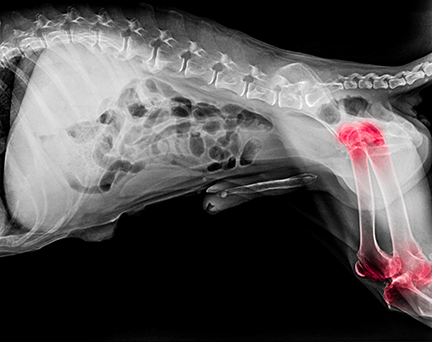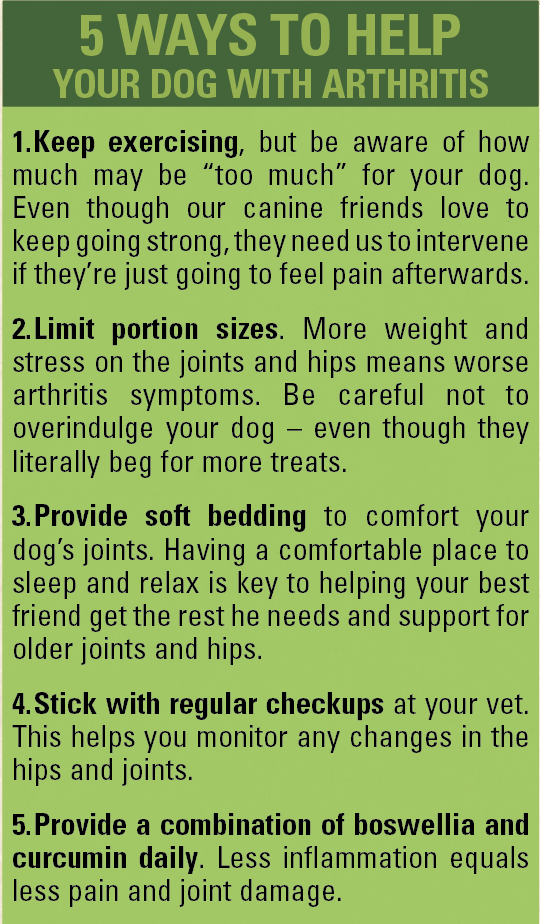Anyone Can Have Hip and Joint Problems – Including our Best Friends
We share a lot in common with our canine companions. Sometimes, that means we also share some of the same health issues. Joint and hip problems are definitely among them. While there are certain breeds of dog that are more prone to developing osteoarthritis or hip dysplasia, simple aging and wear and tear can contribute quite a bit – just like it does for us. In fact, according to statistics in the journal Frontiers in Veterinary Science, osteoarthritis affects up to 15 million dogs in America, most over eight years old, and canine hip dysplasia is one of the most common degenerative joint conditions.

As dogs age, the cartilage between the knees and in the hips breaks down, releasing joint fluid and potentially creating inflammatory damage to the structure of the joints, as well as a great deal of pain. You may notice that in the way that your dog slows down toward the end of your regular walks, lays down gingerly and gets up slowly, or is reluctant to jump or to climb stairs. And in the beginning, they may hesitate a bit prior to doing anything that requires effort and activity, even if they look like they’d like to play or go for a stroll.
In fact, one of the barriers to dogs getting the treatment they need for osteoarthritis and hip dysplasia can actually be due to their owners not recognizing their canine companion is in pain. Either they’ve become used to their dog’s behavior, or they don’t want to think their canine companion is suffering. In an article published in the American Journal of Veterinary Research, veterinarians in Finland asked dog owners to note on a questionnaire how much pain their dogs experienced. What they found was that initially, many pet owners couldn’t tell that their dogs were in pain, even when it was obvious to a veterinarian. However, as the study progressed, owners noted a change when their dogs were taking a pain reliever – and then really noticed the difference after a little time passed and they were instructed to stop giving their dogs a pain reliever.
If any of this sounds familiar – and daunting – it doesn’t have to be. There are ways of addressing this without the need for potentially dangerous prescription steroid drugs or even common non-steroidal anti-inflammatory drugs. It’s very likely that your dog has been taking glucosamine. Maybe that’s been working and you want something additional to back it up. Or, maybe you’ve noticed it is no longer as effective, and your vet is recommending Rimadyl, another NSAID that can cause liver damage, vomiting, diarrhea, fatigue, and ulcers. Fortunately, you can avoid that step.
It so happens that two of the most effective botanical ingredients for stopping pain, restoring range of motion, and supporting healthy joints can work as well for canines as they do for humans. And they do so without causing side effects. Boswellia (Boswellia serrata) and curcumin from turmeric (Curcuma longa) are clinically studied –in dogs to help overcome osteoarthritis pain.
Stopping Inflammation, Pain, and Joint Damage – Safely and Effectively
Boswellia is especially helpful for joint and hip pain because it tackles a pain-causing enzyme that other powerful pain relieving botanicals and drugs struggle to defeat called 5-lipooxygenase, better known as “5-LOX.”
5-LOX activates inflammatory leukotrienes and is a major factor in arthritis pain and joint destruction. Researchers find that elevated levels of 5-LOX activity in the synovial fluid between the joints in cases of arthritis, over time, damages their very structure.
Because boswellia directly inhibits 5-LOX and prevents the formation of leukotrienes, it stops an inflammation cascade from starting. It doesn’t just alleviate pain – it can stop the cause of the pain and preserve your dog’s joints. Additionally, reducing 5-LOX activity may also help relieve your dog’s digestive or respiratory issues, so including boswellia in their daily regimen can provide many benefits.
And although botanical ingredients for joints tend to become more effective over time, you may notice a difference in your dog relatively quickly. In a multi-center veterinary clinical trial, 71 percent of canines with chronic joint and spinal conditions saw noticeable results in just two weeks. They showed less joint stiffness, an improved gait, and reduced local pain at the joints. Over time, they showed better physical movement after exercise or right after rest – two key times when we might notice our own dogs looking really worn out after a regular walk or reluctant and struggling to get up from a nap.
I think your choice of boswellia is critical here, though. Like many plants, boswellia has compounds that can help prevent inflammation or that can actually cause it. The boswellia I prefer is standardized to provide enhanced levels of a compound called acetyl-11-keto-B-boswellic acid, best known by its abbreviation, “AKBA.”
What I like about this boswellia extract is that it has naturally high levels of AKBA – the compound most associated with stopping 5-LOX activity – but it isn’t “spiked” with the compound. Plus, the boswellia extract I prefer also reduces levels of another component of boswellia called beta-boswellic acid, which can be pro-inflammatory. That’s definitely something your best friend doesn’t need.

Curcumin Relieves Pain
Along with boswellia, curcumin from turmeric (Curcuma longa) stops joint pain by blocking cyclooxygenase-2 – COX-2 – activity, among many other forms of inflammation.
In a veterinary clinical study, a combination supplement with curcumin (combined with green tea extract and collagen) reduced pain by 30 percent in just three months. This time frame is not unusual in alleviating joint issues for canines or humans. Botanicals like curcumin and boswellia start reducing inflammation right away – and help decrease pain –- but it can take time to be most effective. It is certainly a better option than NSAIDs, which can cause the same gastrointestinal damage to dogs as they can to people.
And the type of curcumin you use can make a difference, too, and may work even faster. Curcumin, in its regular standardized forms, can be difficult for the body to absorb. However, combining high-quality, standardized curcumin with turmeric essential oil not only enhances absorption and blood retention time, it also provides ar-turmerone, a component of the oil with anti-inflammatory power of its own. This curcumin, which I prefer, has been shown to be significantly better absorbed in dogs than standard curcumin extract.
Your Dog Can Age Gracefully and Actively
We all want to spend as much quality time with our canine best friend as possible. Boswellia and curcumin are two botanical ingredients with the power to help us do exactly that.

To help your best friend feel their best, and safely reduce joint and hip pain, I recommend adding curcumin combined with turmeric essential oil for enhanced absorption along with boswellia that is standardized for a higher level of inflammation-fighting AKBA.
